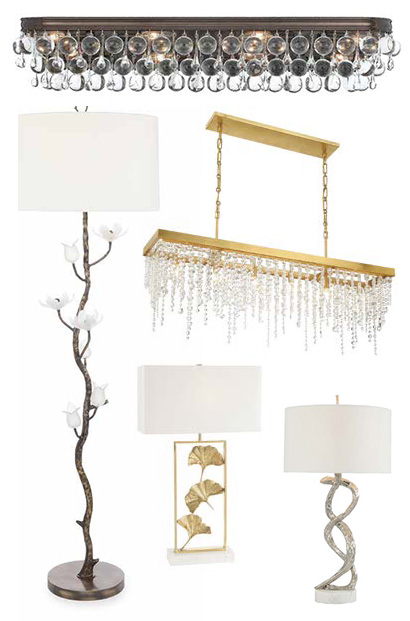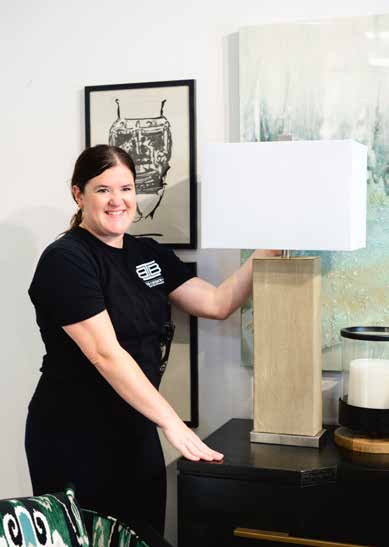The Importance of Lighting in Interior Design

Expertly-placed lighting is a vital aspect of any interior design project. Adding additional dimensions, lighting brings a space to life. Lighting serves many functions, such as creating depth and height, generating cozy spots, and drawing attention to a room’s most impressive areas. Light and the contrast of light and shadow affect our mood and enhance our perception of other elements. Colors, textures, features, and even furniture can be affected by skillfully designed interior lighting. The main categories are ambient, task, and mood lighting. All three serve different but equally important roles in a space’s overall lighting design. This delicate balance brings new energy to spaces and can change an ambiance and overall mood of a room by the flick of switch.

Ambient Lighting: The glow surrounding all spaces.
Also called general lighting, ambient lighting provides overall illumination for a room and is intended to create a uniform light level throughout a space. It should be independent of any special lighting needed in targeted areas of a room. Ambient lighting provides the foundation and general illumination of a room. Aside from basic functionality, advantageous ambient lighting generates that sense of warmth and depth in your space. Ambient lights most commonly hang from the ceiling, such as recessed lights, chandeliers, and track lights. Table and floor lamps can also contribute to a room’s ambient lighting, especially if using the lamp lights up the majority of the room.
Task Lighting: Illumination for specific jobs.
Task lighting, as the name suggests, is designed to help perform specific tasks. It provides concentrated light in a particular area to aid in activities such as reading, cooking, or working. The main consideration for task lighting is ensuring its brightness is fit for the intended purpose. It should be brighter than ambient lighting and focused on the project or hobby at hand. Getting task lighting right means the difference between a comfortable workspace or one that is tiresome and distracting. Make sure to pay attention to any other light sources in the room in order to position task lights where they can do the most good. This may seem obvious, but placement is super important when it comes to effective and comfortable task lighting. For example, a reading chair with a window to the left needs a task light on the right to help eliminate shadows and more evenly illuminate the space. Situating a task light in front of a screen will create an unpleasant glare, while positioning a floor lamp in front of you can cast weird shadows down your book and produce light that is too bright on the page. Try to place desk lamps away from screens and monitors, keeping the overall light in the room bright and even. Use small desk lamps to illuminate key areas without creating a glare on whatever screen you may be using at the time.

Mood: Create Atmosphere in the room.
Mood lighting is using lighting to create a desired atmosphere in any room. It layers your lighting by having multiple sources of light such as lamps, wall lights and ceiling lights, so that you can change the light levels easily. It’s all about being in control of the mood you want to create in your home. Keep cooler lights higher in the room (such as in overhead lighting) and warm lights lower (in table or floor lamps), for optimal functionality and mood. Avoid using a single overhead light fixture with one strong bulb, as the glare and shadows this can create are tiring on both the eye and brain functions. Instead, use several lesspowerful lights placed carefully around the room. Bulbs with lower wattage create a gentler glow. If possible, install a dimmer switch so you can change levels distributed by a single light fixture. Easy examples of mood lighting for a quick install are under-cabinet lighting, spotlights, picture lights, chandeliers, wall sconces, and table and floor lamps with dimmers or differently colored bulbs.
Choose your light bulb’s strength and color by room. For example, bathroom lighting should energize in the mornings, while bedroom lighting should help calm and ready you for sleep. A sunrise projection lamp can rouse you from bed on those mornings when the snooze button is too tempting. Wall sconces can complement an overhead light and provide a non-distracting atmospheric backdrop. Fun fact: Red or amber light is the least likely hue of light to have an impact our internal clocks. Red light in the evening increases secretion of melatonin, which leads to better sleep at night and could ultimately help improve mental health!
Lighting is an essential feature of the ambiance and overall mood of a room. The right lighting setup can make a room feel larger. Combining incoming natural and artificial lighting sources is vital to making an old, tired room feel brand new or for taking a new room design to the next level. Lighting elements should complement the design and décor of the space, and in doing so successfully, the right light can achieve the perfect balance among style, comfort, and practicality.

